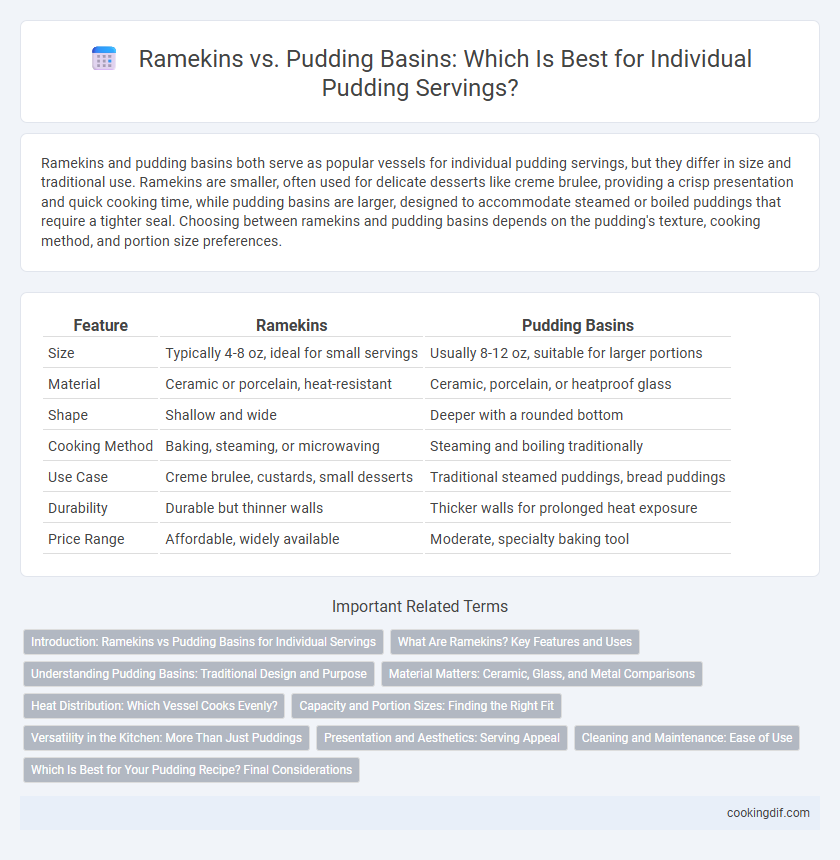Ramekins and pudding basins both serve as popular vessels for individual pudding servings, but they differ in size and traditional use. Ramekins are smaller, often used for delicate desserts like creme brulee, providing a crisp presentation and quick cooking time, while pudding basins are larger, designed to accommodate steamed or boiled puddings that require a tighter seal. Choosing between ramekins and pudding basins depends on the pudding's texture, cooking method, and portion size preferences.
Table of Comparison
| Feature | Ramekins | Pudding Basins |
|---|---|---|
| Size | Typically 4-8 oz, ideal for small servings | Usually 8-12 oz, suitable for larger portions |
| Material | Ceramic or porcelain, heat-resistant | Ceramic, porcelain, or heatproof glass |
| Shape | Shallow and wide | Deeper with a rounded bottom |
| Cooking Method | Baking, steaming, or microwaving | Steaming and boiling traditionally |
| Use Case | Creme brulee, custards, small desserts | Traditional steamed puddings, bread puddings |
| Durability | Durable but thinner walls | Thicker walls for prolonged heat exposure |
| Price Range | Affordable, widely available | Moderate, specialty baking tool |
Introduction: Ramekins vs Pudding Basins for Individual Servings
Ramekins and pudding basins both serve as essential vessels for individual pudding servings, but their differences lie in size, material, and traditional use. Ramekins are smaller, typically made of ceramic or porcelain, ideal for custards, souffles, and small portions of pudding, offering a delicate presentation. Pudding basins are larger, often made of ceramic or heatproof glass, designed to withstand boiling or steaming, making them suitable for classic steamed puddings and denser desserts.
What Are Ramekins? Key Features and Uses
Ramekins are small, cylindrical ceramic or glass dishes typically measuring 3 to 6 ounces, designed for individual servings of desserts like puddings, custards, and souffles. Their key features include heat resistance, even heat distribution, and a non-porous surface, making them ideal for oven baking and easy cleaning. Ramekins are versatile for both sweet and savory dishes, offering elegant presentation and portion control for single servings.
Understanding Pudding Basins: Traditional Design and Purpose
Ramekins and pudding basins serve different purposes in individual dessert preparation, with pudding basins traditionally designed to accommodate steamed or boiled puddings. Pudding basins are typically deeper, made from heat-resistant ceramic, and equipped with a rounded lip to secure a cloth or foil cover during cooking. Their classic design ensures even heat distribution, essential for achieving the desired texture in traditional British puddings like suet or Christmas pudding.
Material Matters: Ceramic, Glass, and Metal Comparisons
Ceramic ramekins offer excellent heat retention and even cooking, making them ideal for traditional pudding textures, while glass basins provide visual appeal and allow easy monitoring of the cooking progress without disturbing the dish. Metal pudding basins, typically made of stainless steel or tin, heat quickly and evenly but may cause quicker browning or uneven texture if not carefully monitored. Choosing the right material depends on balancing thermal conductivity, aesthetic preference, and the specific pudding recipe requirements.
Heat Distribution: Which Vessel Cooks Evenly?
Ramekins, typically made from ceramic or porcelain, provide consistent heat distribution, ensuring the pudding cooks evenly without hot spots. Pudding basins, often crafted from thicker materials like ceramic or glass, retain heat well but can sometimes result in uneven cooking if heat penetration is slower. For optimal results, ramekins are preferred for delicate, uniform cooking of individual pudding servings due to their superior heat conduction properties.
Capacity and Portion Sizes: Finding the Right Fit
Ramekins typically hold between 4 to 8 ounces, making them ideal for smaller, delicate pudding portions that emphasize presentation and controlled serving sizes. Pudding basins generally offer larger capacities ranging from 8 to 12 ounces or more, accommodating heartier, traditional puddings suited for generous individual servings. Selecting the right vessel depends on desired portion size and recipe requirements, with ramekins favoring precise, elegant servings and pudding basins supporting more substantial portions.
Versatility in the Kitchen: More Than Just Puddings
Ramekins offer exceptional versatility in the kitchen, serving not only as perfect vessels for individual puddings but also for souffles, custards, and small casseroles, enhancing multi-purpose use. Pudding basins, traditionally designed for steamed desserts, can double as molds for chilled dishes or even ice cream servings, making them adaptable beyond their original purpose. Both options provide durable, oven-safe solutions that streamline preparation and presentation of diverse recipes, elevating everyday cooking efficiency.
Presentation and Aesthetics: Serving Appeal
Ramekins offer a refined and elegant presentation for individual pudding servings, often enhancing the visual appeal with their smooth, uniform shapes and glossy finishes. Pudding basins, typically larger and more utilitarian, provide a traditional charm but lack the sleek, polished aesthetic that ramekins deliver on the plate. Using ramekins can elevate the dining experience by creating visually appealing, perfectly portioned desserts that highlight the pudding's texture and color.
Cleaning and Maintenance: Ease of Use
Ramekins often feature smooth, non-porous surfaces that make cleaning effortless and reduce the risk of residue buildup, ideal for quick turnaround in busy kitchens. Pudding basins, typically designed with thicker walls and sometimes intricate shapes, may require more careful washing to avoid trapped food particles. Choosing ramekins can enhance ease of use through simpler maintenance, saving time and ensuring consistent hygiene for individual pudding servings.
Which Is Best for Your Pudding Recipe? Final Considerations
Ramekins and pudding basins both serve well for individual pudding servings, but ramekins are ideal for custard-based or lighter desserts due to their size and heat distribution. Pudding basins excel for traditional steamed puddings requiring a tight lid to trap steam and maintain moisture during cooking. Choosing the right vessel depends on your specific recipe's cooking method, texture, and portion size requirements to achieve perfect consistency and presentation.
Ramekins vs pudding basins for individual servings Infographic

 cookingdif.com
cookingdif.com